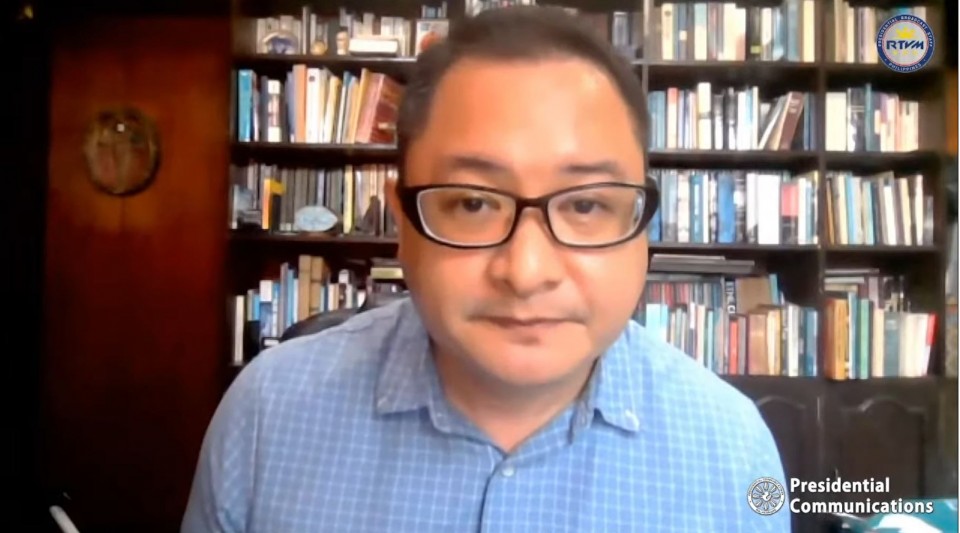But Omicron will only have “mild” effect on fully vaccinated, says Dr. Salvana who notes that PHL can ride the Omicron wave with more vaccinations, booster shots


(Eagle News) – A “fleeting contact” is all it takes for the Omicron variant to spread, unlike previous COVID-19 virus variants that takes at least 15 minutes between close contacts to be transmitted.
Dr. Edsel Salvana from the Department of Health Technical Advisory group on infectious diseases, explained that the Omicron variant, while much milder than the Delta variant, is spread much much faster, with symptoms being exhibited three days after contact.
The good news is that with the Omicron variant, it is not only milder especially for the fully vaccinated, but it is similar to the flu which could be treated at home in most cases for the fully vaccinated, he said.
Omicron can still be prevented by wearing face masks, face shields, maintaining physical distance and getting vaccinated, he told President Rodrigo Duterte during last Thursday’s Talk to the People.
“Ang problema po kasi talaga it’s not 15 minutes na lang eh, fleeting contact lang puwede kang mahawa from Omicron. It’s very, very contagious and it spreads very fast,” Dr. Salvana noted.
“If it takes five days to get symptoms from Delta, it only takes three days to get symptoms from Omicron. So mabilis ‘yung paghawa niya kasi when people have symptoms mas nakakahawa sila,” he said.


Dr. Salvana who is also the Director, Institute of Molecular Biology and Biotechnology, said that the treatment for Omicron is for the most part the same as with other COVID-19 cases.
Omicron also infects even the fully vaccinated individuals, but they would have less severe symptoms if infected.
But it poses a danger for those who are unvaccinated as they would get more severe symptoms.
-Less danger, less risk for fully vaccinated-
“So just to update you, Mr. President, on Omicron and we are getting more and more data about this, it really is more transmissible than Delta, particularly because ‘yung vaccines, nahahawa pa rin kahit fully vaccinated. Although, our vaccines continue to work naman to decrease the risk of severe disease. It is less deadly compared to Delta,” he said.
Comparing about 500,000 people with Omicron with the 500,000 people with Delta in the United Kingdom, “you are three times less likely to get hospitalized with Omicron compared to Delta.”
He said that full vaccination and boosters will add more protection against getting the severe COVID.
“And of course, that goes down even more kung bakunado po kayo. And the vaccines significantly still protect against severe disease. Giving boosters will add more protection and vaccines also decrease infectiousness and risk of mutation,” the health expert explained to the President.
“So if you are vaccinated, may chance na mahawa ka pero most likely magiging mild po ‘yun and even ‘yung paghawa mo sa ibang tao, ‘yung risk goes down kasi mas mababa po iyong amount of virus that you release into the air,” he said.
He also compared the situation of the Omicron cases in South Africa where the Omicron variant was first announced.
In Gauteng province in South Africa, the hospital admissions are not that high compared to the cases, and the deaths were also low.
With a high vaccination rate, the cases are milder and the deaths are lower even with high cases of the Omicron variant.
But the effect is that more health care workers are infected since it is highly transmissible. If infected, the health workers are isolated or quarantined, so are their close contacts, thus affecting health care workers who can attend to COVID-19 cases.
“So even if we’re seeing many, many cases, basta mataas ang vaccination rate natin, we hope that the number of people who will end up in the hospital will remain relatively smaller and the number of people who will die will remain low. The problem is, iyon nga pati ‘yung healthcare workers natin nagkakasakit eh. So kailangan po talaga natin rin silang protektahan,” he said.
-Prioritize “sickest of the sick” in hospitals-
Salvana said that hospitals need to prioritize the “sickest of the sick.” Many mild and moderate cases still go to the hospitals “crowding out people who really need to be in the hospital.”
Salvana, who is also under quarantine after exposure to a COVID case, said he is confident that the country could still ride the Omicron wave with more vaccinations especially in the regions with low vaccination rates, and with the administration of more booster shots.
If people get the Omicron and they are fully vaccinated, it would be just similar to the flu, he said, which could be treated at home.
-Home care for mild cases recommended-
“So we hope that as long as maraming nabakunahan, we can actually take care of these people at home safely because their risk of bad disease kung Omicron ‘yan and fully vaccinated sila, is very low. Parang sa flu lang po. So again, basta bakunado, kahit mahawa ng Omicron chances are it’s going to be mild. It’s going to be like the cold or the flu,” he told President Duterte.
“And as long as they are able to isolate as soon as possible para hindi sila makahawa sa ibang tao, we will — hopefully will be able to ride out the Omicron wave po,” he added.
As of Friday, January 7, new COVID-19 cases in the Philippines reached a high of 21,819 cases, the highest since September last year. Most of the 77,369 active cases as of Thursday are just mild cases.
(Eagle News Service)
